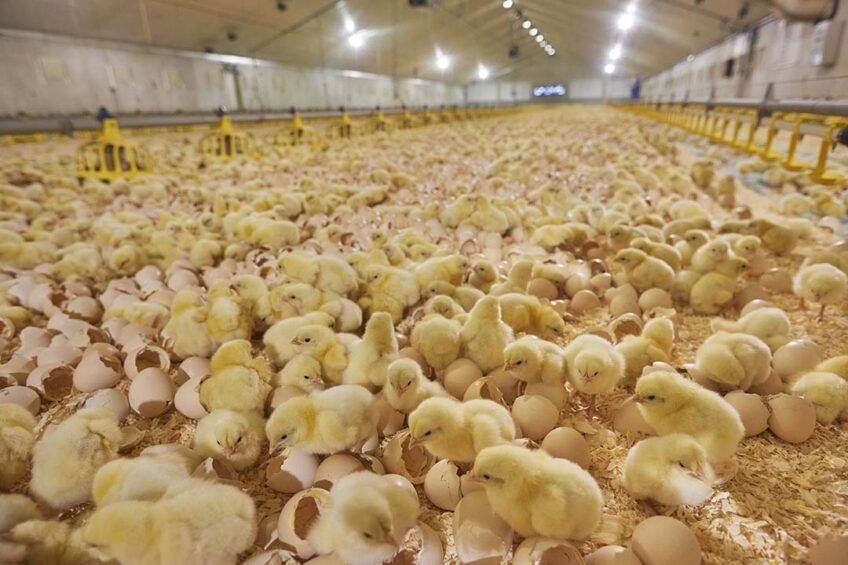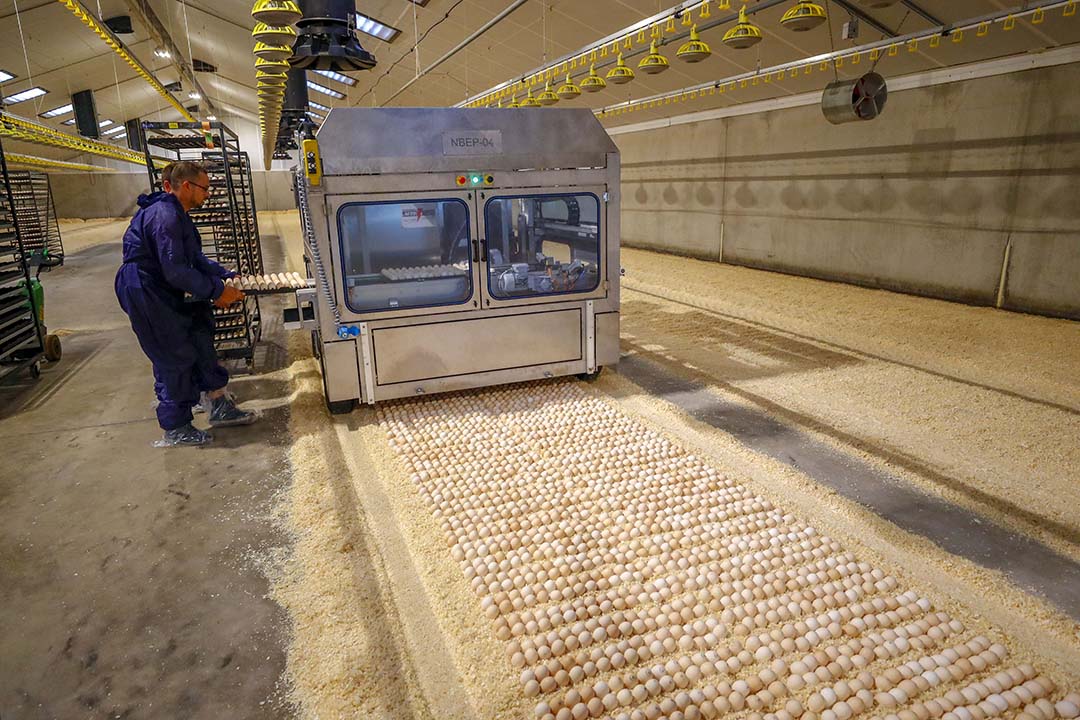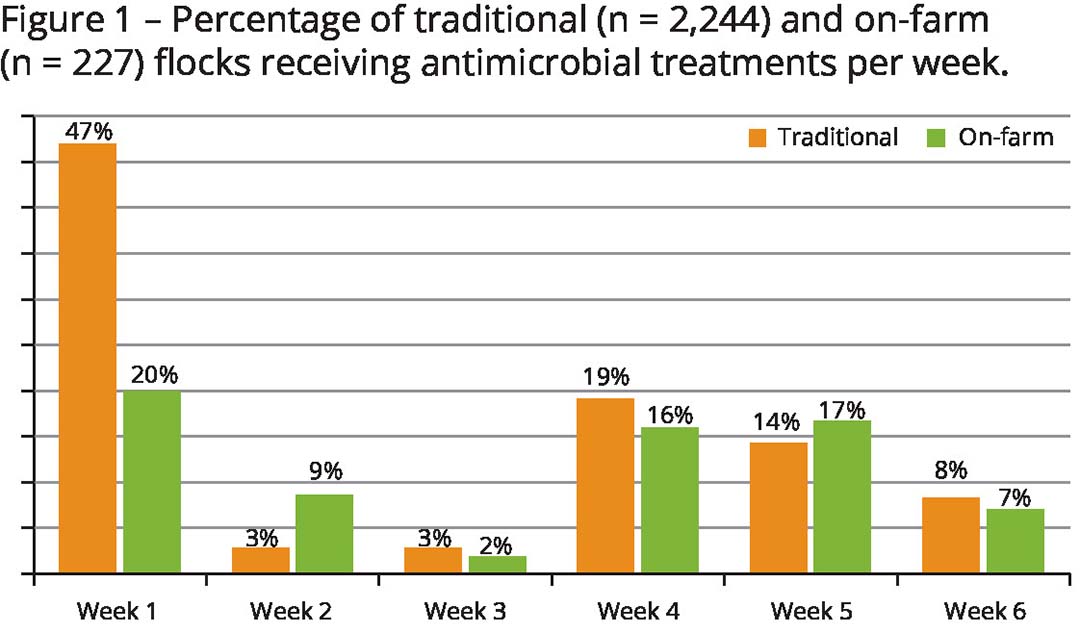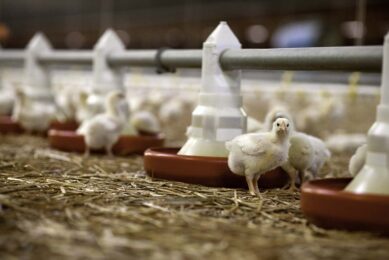On-farm hatching leads to significantly lower antimicrobial use

In a case study using data from 2,471 broiler flocks, on-farm hatched flocks had significantly more antimicrobial-free flocks (48%) compared to traditional flocks (12%). In addition, on-farm hatched flocks had a significantly lower treatment incidence (TI) (44%) at flock level (TI 8.40 vs TI 15.13). Farms using traditional hatching had a 5.6 times greater probability of using antimicrobials than those using on-farm hatching.
On-farm hatching is more and more widely used in Europe to tackle welfare issues, for example, and to try to reduce the use of antimicrobials, which is a worldwide problem that requires innovation on various fronts.
In traditional hatching systems, chick density in the hatchers remains very high until all have hatched during the expected ‘hatching window’ of up to 24-36 hours (h). Throughout this period the chicks usually have no access to feed and water, resulting in a total period of up to 48 h of feed and water deprivation.
In on-farm hatching systems, eggs are brought to the broiler farm on day 18 of incubation (range is 17-19 days), where the chicks have immediate and uninterrupted access to feed and water after hatching. They also no longer undergo stressful post-hatch processing, like grading, counting, packaging and transport. The clean environment in which they are born is also claimed as an important issue.
Compared with traditional hatching systems, based on a variety of benefits, the European Food Safety Authority (EFSA) states that transporting fertilised eggs in the context of on-farm hatching is the only way to minimise welfare consequences during transport and on the broiler farm. The EFSA also emphasises that state-of-the art animal welfare practices further help to make day-old chicks and broilers healthier.
Jerab and others in the Faculty of Veterinary Medicine at the Ghent University in Belgium used data from 2,471 commercial flocks in Belgium to quantify the effect of the hatching method. In this large-scale case study they quantified and compared antimicrobial use in flocks that were hatched using traditional hatching systems with those hatched using on-farm hatching. The results of this scientific study have been recently published.

Collection of data
The antimicrobial use data was collected from 211 Belgian broiler farms with treatment incidence (TI) used to quantify the antimicrobial use in a standard manner (see box at the end of this article). Of these 211 farms, 204 farms (415 houses) applied traditional hatching methods, while 28 farms (54 houses) applied on-farm hatching methods. Of the 204 farms that applied traditional hatching at the start of the period of data collection (2 January 2020), 21 farms (36 barns) moved to on-farm hatching during this period (until 31 December 2020). Antimicrobial use data for 2,244 traditionally-hatched flocks and 227 on-farm hatched flocks were collected in total. Flock size was comparable and averaged 30,300 birds.
All farms had conventional broiler production with no slow-growing breeds. All flocks, regardless of hatching method, were thinned once (25% of chicks at a weight of ±2.0 kg), and the remaining 75% were slaughtered at day 40-42 with a final weight of around 2.7 kg. Vaccination did not differ between the 2 groups. All broiler data included in the dataset originated from 2 Belgian hatcheries that were both part of the same integration with common health and management among all broiler breeders.
Treatment incidence
Antimicrobial treatment was administered in 2,091 flocks (84.62%) of the 2,471 total production flocks included in the dataset, with a remaining 380 antimicrobial-free production flocks. The 2,091 treated flocks consisted of 1,973 traditionally-hatched flocks and 118 on-farm hatched flocks, leaving 12.07% non-treated traditionally-hatched flocks (271) and 48.01% non-treated on-farm hatched flocks (109).
Farms using traditional hatching systems had 5.6 times higher probability of using antimicrobials than farms using on-farm hatching systems (95% CI: 3.6-8.8). When the treatment incidence in all 2,471 followed production rounds, regardless of whether or not they received antimicrobials, was compared on basis of the hatching system, on-farm hatched flocks had a 44% lower treatment incidence (p < 0.01) (TI 8.40, CI [6.31-10.49]) compared to traditionally hatched flocks (TI 15.11, CI [14.36-15.85]). Breeder farms (p = 0.19) and flock size (p = 0.83) were also taken into account, however, neither had a significant impact on the antimicrobial use.
 When only the treated flocks are considered, on-farm hatching flocks had a slightly lower (p < 0.01) median AMU (TI 11.69, CI [8.77-15.12]) compared to traditionally-hatched flocks (TI 13.14, CI [12.60-13.71]). In the treated traditional production rounds, 75% of the total treatment incidence took place within the first week, compared to 51% in treated on-farm hatching rounds. Furthermore, in traditionally-hatched production rounds, 37% of all antimicrobial administration took place within the first 2 days of the production round, more than double compared to on-farm hatched flocks (16%).
When only the treated flocks are considered, on-farm hatching flocks had a slightly lower (p < 0.01) median AMU (TI 11.69, CI [8.77-15.12]) compared to traditionally-hatched flocks (TI 13.14, CI [12.60-13.71]). In the treated traditional production rounds, 75% of the total treatment incidence took place within the first week, compared to 51% in treated on-farm hatching rounds. Furthermore, in traditionally-hatched production rounds, 37% of all antimicrobial administration took place within the first 2 days of the production round, more than double compared to on-farm hatched flocks (16%).When comparing the percentage of flocks that received a diagnosis resulting in antimicrobial use per week, antimicrobial use occurred in 94.62% of the weeks for traditionally-hatched flocks, whereas antimicrobial use took place in 69.64% of the weeks in on-farm hatched flocks. Both on-farm and traditional flocks saw an increase in antimicrobial use during week 4, with 19% and 16% of all flocks (treated and untreated) receiving treatment, respectively (Figure 1).
In both traditional production and on-farm hatching, lincomycin-spectinomycin (linco-spectin) (TI 6.83, SD 7.41 vs TI 2.13, SD 5.65, respectively) and tetracyclines (TI 3.82. SD 12.80 vs TI 3.08, SD 11.83, respectively) were the most commonly used antimicrobials (Table 1). Linco-spectin use was 3 times higher in traditional flocks compared to on-farm hatched flocks. These results indicate that on-farm hatching may contribute substantially to the decrease in antimicrobial use in broilers and could thereby play an important role in the future of more sustainable and ethical broiler production.
References available on request.
The Poultry World Newsletter
Sign up for our newsletter and receive all our need-to-know content three times a week.
Join 31,000+ subscribers
Subscribe to our newsletter to stay updated about all the need-to-know content in the poultry sector, three times a week. Beheer
Beheer











 WP Admin
WP Admin  Bewerk bericht
Bewerk bericht